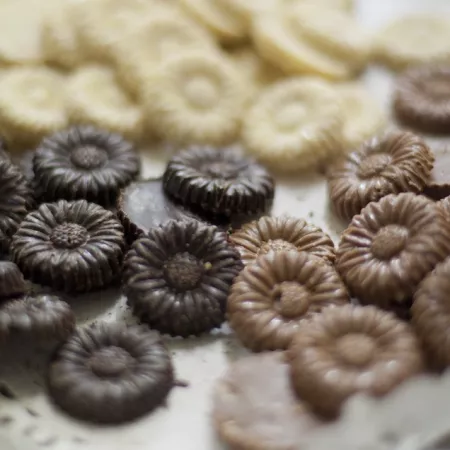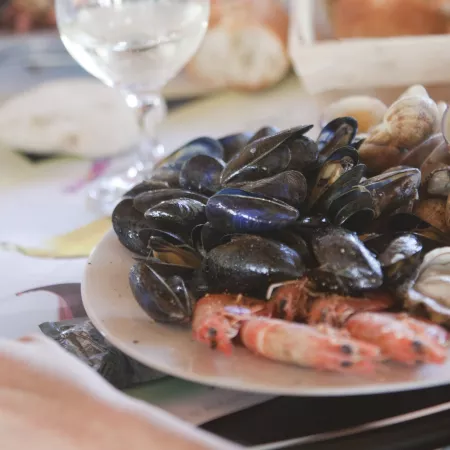Flavours of the Charentes and the Périgord
Oysters from the islands out west or black truffles from the Périgord out east, savour all the flavours of these regional cuisines. Practically every stage of La Flow Vélo® can offer your palate surprises that you may not be able to resist. Discover sea-related recipes, specialities from the Charentais terroir, and delicious delicacies from all around the lands you cycle through.
Seafood
Cycling along the westerly, coastal stretches of our cycle route, the sea air whets the appetite. Test out oysters from the nearby islands or from Marennes-Oléron, langoustines from La Cotinière, and whelks, cockles, clams and bittersweet clams that feature on local seafood platters.
Summer is the season for regionally cultivated mussels. Taste them à la marinière (in wine or cider sauce) or en mouclade, with cream and curry, accompanied by a glass of white Charentais wine, of course.
In Charentes, a fish of the day is often on offer, with seabass, Atlantic shadefish (maigre in French) and sea bream the emblematic line-caught fish. They’re delicious accompanied by potatoes from the nearby île de Ré and a few stems of samphire. Children might prefer sole meunière or fried baby sole.
Perhaps you’re not familiar with chaudrée, a traditional dish based on various sorts of fish.
In the past, it was made with small fry, little fish too small to be cooked singly. La chaudrée fourasine, a version that takes its name from the port of Fouras, is made with eels and cuttlefish.
Tasty regional specialities
Perhaps a galette charentaise might tempt you at tea time. Especially when made with top-quality Charentes butter, and particularly delicious filled with blueberries or little pieces of local candied angelica.
Poitou-Charentes goat’s cheese is very widely available across the region. It even goes into making a regional dessert, the tourteau fromager, a light, round cake with a distinctive blackened crust.
Of longer-standing is the reputed caillebotte, a cow or goat’s milk curd to be savoured with sugar or some local honey. The jonchée, wrapped in rush straw, is the Saintonge Region’s version, flavoured with almond.
In Angoulême, do try a tasty cornuelle, a triangular biscuit dotted with aniseed-flavoured seeds. With a coffee, bite into a chocolate Marguerite, a sweet speciality from Angoulême, created in 1876 in honour of 16th-century royal writer, Marguerite d’Angoulême.
The Périgord walnut, cultivated since the 19th century, is protected by its own Appellation d’Origine Contrôlée. Its area of cultivation extends across four départements (French counties), including Charente and Dordogne. It’s delicious accompanied by a Reinette de Saintonge, one of the oldest French apple varieties, appreciated since the 10th century!
Cuisine du terroir
Riding through different areas, or terroirs, with their distinctive geology and climate, the local cuisine is packed with country flavours, combining produce from the countryside with meat from animals reared in the local meadows of the hedge-divided fields of the bocage.
Grillon charentais is a kind of coarse pâté, or rillettes, best tasted on a lovely slice of country bread during a riverside picnic. As to charentais melon, you can eat it either as a starter or as a dessert. It tastes extra special when you first pour a small glass of chilled pineau des Charentes (a wine fortified with cognac spirit) into a half-melon!
Some even go as far as adding a pinch of fleur de sel, finest sea salt from l’île de Ré or l’île d’Oléron, to bring out the delicate flavour even more.
A Chalais veal cutlet flavoured with charentais saffron, served with Jarnac carrots, is a delicious main dish to sample. Or try agneau diamantin de pré-salé, lamb reared in salt marshes, served with mogette white beans from the Arnoult Valley, simmered to melt in the mouth.
For a special dinner, Barbezieux capon, appreciated in these parts since the Middle Ages, is an exceptional dish, sometimes served with Périgord black truffles. As to cagouilles, they are charentais snails, to be savoured in a whole range of ways, from salads to omelettes – there are countless recipes for them in these parts!
Gourmet cuisine
Périgord cuisine is renowned for its goose or duck foie gras. Foie gras can be served in a variety of forms: whole; fresh; or mi-cuit (semi-cooked). The accreditation IGP Canard à Foie Gras du Sud-Ouest Périgord guarantees both origin and quality.
In Sarlat, foie gras is often served with Sarladais potatoes. Delicious!

